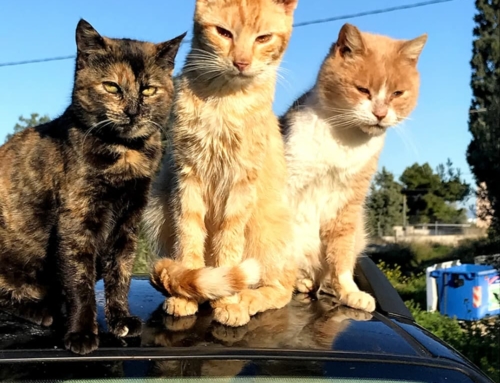Unfortunately lots of dogs and cats are getting poisoned on Aegina, although it’s against the law and totally unhuman! Although local authorities are aware of this situation, too little has been done to stop these practices, the killers are still around! Please read the text below to prepare yourself to save an animal in case of an emergency or learn what you can do to contribute to stop the poisoning!
text by Elizabeth Koubena
It is very distressing to find an animal that has been poisoned but if you take immediate action, you may be able to save it. First it is important to be able to recognize the type of poison that has been used.
What kinds of poisons are commonly used in Greece?
Insecticides, strychnine and warfarin (rat poison)
They are mixed with strong tasting foods – canned pet food, sausages, meat balls and raw meat to disguise them. All of these poisons cause incredible pain to the animal and are lethal unless the animal is treated in time.
How do you recognize that an animal has been poisoned?
- Here are the symptoms of:Organo-phosphate poisoning (insecticides) – salivating at the mouth, excessive tears, diarrhea, severe vomiting, constriction of the pupil, muscle twitching, asthmatic breathing, trembling, convulsion and coma. TREATMENT: Get the animal to a vet as soon as possible. To give the animal the best chance of surviving, however, you should learn to administer first aid. Here’s what you do.
- Induce vomiting as soon as possible: give salt or baking soda dissolved in lukewarm water into the mouth. But a Warning – if an animal shows signs of nervousness such as trembling, staggering or collapsing, do not attempt an emetic as it could damage the lungs. Continue to the next step instead.
Give an injection of atropine (1 vial for a cat or small dog, 2 to 3 vials for larger dogs). Atropine can be injected into the vein (absorbed most quickly), into the muscle (absorbed less quickly) or under the skin (slowest absorption but the easiest to give). Most people have trouble giving an injection but you can practice on an orange or get your vet to show you how; time is of the essence so learning to give this injection could save a life.
You can buy Atropine in plastic vials at the pharmacy without a prescription at a very low price. Keep in car and at home (they will deteriorate in very hot weather so are best kept in the fridge in the summertime.)
IMPORTANT: An animal that has been poisoned is very sensitive to light and noise so protect it from both; keep it covered and as comfortable as possible when transporting it to a vet.
The other less common poisons sometimes used for animals are:
- Warfarin (Rat poison) – vomiting and diarrhea. Sometimes, however, there will be no symptoms for 2 to 3 days. Then red/purple/dark blue patches appear on body or gums, signs of internal bleeding.
TREATMENT: Injection of Konakion (Vitamin K) to help clot the blood, 5 to 20 mg, depending on size and weight of animal. - Strychnine – Spasms, pupils expand and muscles twitch.
TREATMENT: Injection of diazepam: cats 5-10mg, dogs 10-30mg, depending on size and weight.
If you live in Aegina, you can take steps to avoid animals being poisoned
- Neuter your neighborhood strays so that new victims are not born.
- Do not put stray puppies on the street; they will not survive; try to find homes for them.
- Neuter your own pets to prevent unwanted puppies and kittens being born; many abandoned animals come from homes. Who abandons them? Not the mother!
- Your own animal is in danger. Animals have been poisoned inside their own yards or while going on a simple walk with their owners.
- Do not abandon your pet; it is against the law; it will not survive on the street; it will probably be poisoned.
If you find an animal that has been poisoned and cannot save it, there is action you can take to try and prevent whoever committed the crime from repeating it, because poisoning animals is a crime.
- Greek Law No. 1197 (1981) says: “Whoever kills, harasses or ill-treats animals covered by the present legislation, or abandons them is punishable by Article 8 of the penal code.”
- Greek Law No. 2017 (1992) says: “No one should subject an animal to pointless pain, suffering or distress. No one should abandon a pet.”
The implementation of this law lies with the Interior Ministry (i.e. the municipalities) and the Public Order Ministry (i.e. the police). You should, therefore, report the poisoning to the police and the mayor’s office. You do not need to know who poisoned these animals; you can file a report against unknown persons (called minesi ep’agnostou). A toxicology report, vet’s statement can be used as evidence to substantiate your case; insist that your report be put in the log book! You should also report this to your local vet and local animal welfare group, with photographs when possible.
If you know who poisoned the animals, you can prosecute. The evidence needed is:
- a) statement from a witness,
- b) name and address of the poisoner,
- c) toxicology report of the cause of death from the University of Athens toxicology dept. Outside of Athens ask the police what is the nearest officially recognized toxicology laboratory. If ground glass was used, pieces of glass from the animal’s stomach can be used instead of a report.
There is also action you can take in the neighbourhood where the poisoning took place. Make posters quoting the Greek law mentioned above and report that a poisoning has recently taken place and been reported to the police and that there is now a neighbourhood watch in action which will be on the lookout for those persons who put down poisons for animals. (Of course, this latter part will not be entirely true but how will the person poisoning know this?) If you have a picture of a dead animal that has been poisoned, put it on the photo; it cannot be stressed how effective such a poster can be. And tell all your neighbours about the incident, especially those whom you suspect may have been the poisoners but without accusations of course.
If you see someone putting down poison bait, there is action you can take
Try to find someone else to witness it with you. Gather up the poisoned food and take to the toxicologist for analysis (take it to one of the veterinary clinics on the island). Report this incident to the police within 24 hours. If you can, give the name and address of the poisoner. This case can go before a public prosecutor within 48 hours (called an aftoforo in Greek).
You can also take action if someone threatens to poison an animal
Report threat to the police. It is helpful to have a witness (not related to you) willing to come with you. Give the name and address of the person threatening and ask the police officer to visit him/her as a warning. If it is not your own pet but a stray that has been threatened, tell the police you are a member of an animal welfare group, that the animals are looked after, neutered and vaccinated and pose no threat to the neighbourhood. Insist that your report be recorded!
Be prepared!
Carry a first aid kit with you: bottled water, package of salt, atropine and syringes and a copy of this brochure. Put these things in a plastic bag and in your purse and in your car. Talk to your vet about how to administer first aid and what amounts to give. It can save your pet’s life.
Teach children that poisoning is a terrible crime.
Let us try to stop people murdering animals.


